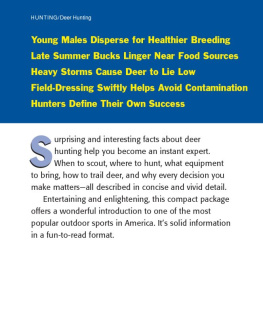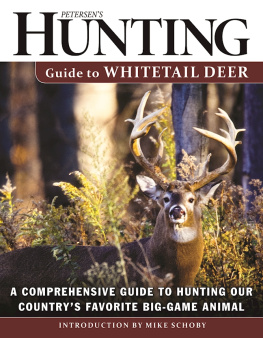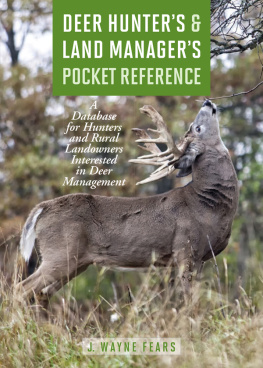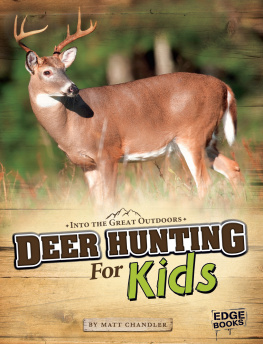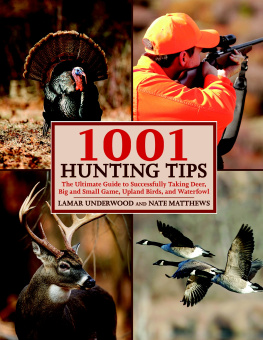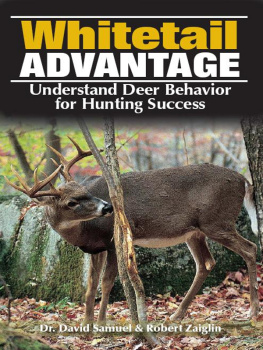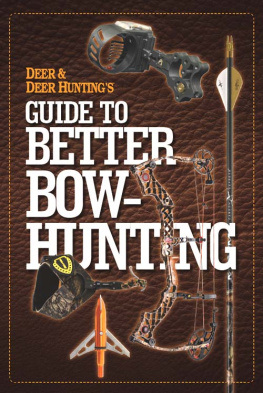J. Devlin Barrick - Deer Hunting: 100 Things to Know
Here you can read online J. Devlin Barrick - Deer Hunting: 100 Things to Know full text of the book (entire story) in english for free. Download pdf and epub, get meaning, cover and reviews about this ebook. year: 2007, publisher: Stackpole Books, genre: Home and family. Description of the work, (preface) as well as reviews are available. Best literature library LitArk.com created for fans of good reading and offers a wide selection of genres:
Romance novel
Science fiction
Adventure
Detective
Science
History
Home and family
Prose
Art
Politics
Computer
Non-fiction
Religion
Business
Children
Humor
Choose a favorite category and find really read worthwhile books. Enjoy immersion in the world of imagination, feel the emotions of the characters or learn something new for yourself, make an fascinating discovery.
- Book:Deer Hunting: 100 Things to Know
- Author:
- Publisher:Stackpole Books
- Genre:
- Year:2007
- Rating:4 / 5
- Favourites:Add to favourites
- Your mark:
- 80
- 1
- 2
- 3
- 4
- 5
Deer Hunting: 100 Things to Know: summary, description and annotation
We offer to read an annotation, description, summary or preface (depends on what the author of the book "Deer Hunting: 100 Things to Know" wrote himself). If you haven't found the necessary information about the book — write in the comments, we will try to find it.
Deer Hunting: 100 Things to Know — read online for free the complete book (whole text) full work
Below is the text of the book, divided by pages. System saving the place of the last page read, allows you to conveniently read the book "Deer Hunting: 100 Things to Know" online for free, without having to search again every time where you left off. Put a bookmark, and you can go to the page where you finished reading at any time.
Font size:
Interval:
Bookmark:
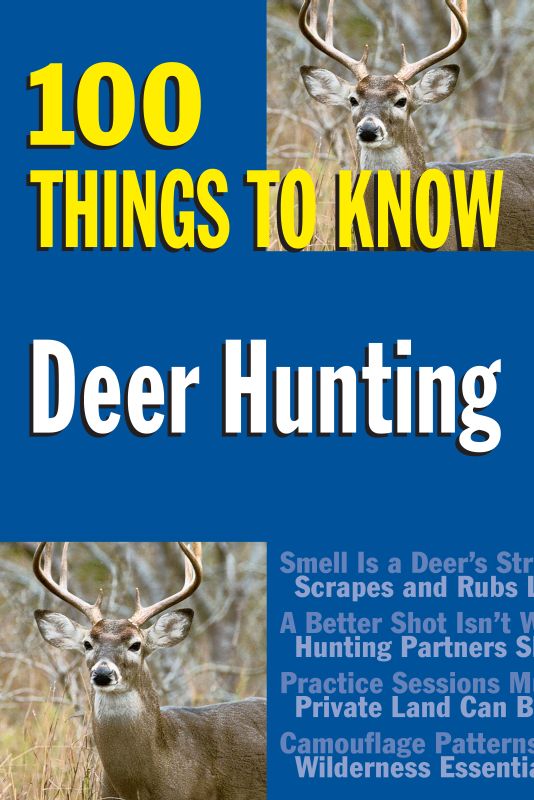

Copyright 2008 by Stackpole Books
Published by
STACKPOLE BOOKS
5067 Ritter Road
Mechanicsburg, PA 17055
www.stackpolebooks.com
All rights reserved, including the right to reproduce this book or portions thereof in any form or by any means, electronic or mechanical, including photocopying, recording, or by any information storage and retrieval system, without permission in writing from the publisher. All inquiries should be addressed to Stackpole Books, 5067 Ritter Road, Mechanicsburg, PA 17055.
Printed in the United States of America
10 9 8 7 6 5 4 3 2 1
First edition
Cover design by Wendy Reynolds
Cover photo Getty Images
Library of Congress Cataloging-in-Publication Data
Deer Hunting : 100 things to know / J. Devlin Barrick, editor. 1st ed.
p. cm.
ISBN-13: 978-0-8117-3445-5
ISBN-10: 0-8117-3445-5
1. Deer hunting. I. Barrick, J. Devlin.
SK301.D383 2008
799.2 765dc22
2007032201
eBook ISBN: 9780811750974
Contents
About Deer
Whitetails and Mule Deer Are Different
Most obviously, a whitetail deer has a broad tail thats white underneath versus the slender, blacktipped tail of a mule deer. A mule deer has large, mulelike ears, unlike the smaller ears of the whitetail. Typical whitetail racks exhibit unbranched tines arising from main beams. Points beyond the brow tine on mule deer antlers typically fork.
Whitetails range from the Atlantic to the Pacific and from the Hudson Bay to Panama. Mule deer also have an extensive range, but it is limited to western North America from central Mexico to just south of the arctic tundra. In the United States, their range extends from western North Dakota, South Dakota, and Nebraska west to the Pacific Coast and adjacent islands.
When running, these two species of deer can be differentiated by their gait. Mule deer employ a stifflegged bounce called stotting. Whitetails run in typical headlong fashion, but also make lengthy leaps or bounds.
Deer Inhabit Thick, Brushy Terrain
Although larger varieties of mule deer are usually found in more open terrain, both mule deer and whitetails are found in stands of timber. Most spend their entire lives in a limited home range of two square miles, and in many cases, less.
If deer live in mountainous or hilly terrain, however, they have distinct summer and winter ranges. Summers are often spent at higher elevations than winters. There is a downhill migration in the fall to escape heavy snows. As the snow melts in the spring or early summer the deer move uphill. Distance of travel may be as great as twenty miles.
Some whitetail deer in northern climates migrate to wintering areas called yards, which are primarily lowland swampy areas. These yarding areas are often south, where snow depths are less. Deer that make seasonal movements often use the same routes year after year, unless habitat change requires an adjustment.
Mulies spooked by hunters may travel miles to a new area. Whitetails seldom roam far. If pushed out of their territory, they usually return.
Smell Is a Deers Strongest Defense
Deer are colorblind. They see shades of black and white. Movement attracts their attention. Their sight is better to the sides than straight ahead because of the position of their eyes. Animals that live in open country tend to depend on their vision more than those in heavily wooded terrain.
The sense of hearing is well developed in deer. Only sounds that are not normal in their environment, such as human voices, metallic sounds, fabric rubbing against brush, or noisy human feet, unduly alarm them.
Deer rely heavily on their sense of smellprobably their strongest defense against hunters. If the wind is right, deer often smell hunters before they are within sight of their quarry. Animals that wind hunters sometimes make a noise by blowing through their nostrils to warn other deer of danger. This sound is often referred to as a snort. Both bucks and does make this sound, which sounds like a train whistle or someone blowing on an empty rifle cartridge.
Deer Eat Tree Buds, Saplings, Leaves, and Grasses
Basically, whitetails and mule deer are browsers, but they also graze on grasses and other vegetation when they are available. Additionally, deer are fond of a variety of agricultural crops. Leaves from trees and plants make up a large part of their diet in the summer and a lesser part in the fall. Deer frequently eat freshly fallen leaves during the fall, however, and sometimes will eat dried leaves from branches or off the ground during winter months.
Deer do most of their browsing in fall and winter. Woody material such as the buds and the tender tips of saplings and shrubs from sagebrush, mountain mahogany, dogwood, willow, maple, and oak are preferred. Evergreen leaves from yew, cedar, juniper, hemlock, and some pines are also favored. Acorns, beechnuts, and apples are prime fall and winter deer foods, when available. It is not uncommon for deer to stand on their hind legs to reach morsels of food on trees, especially in the winter when rations are sometimes in short supply.
Since only the lower jaw has front teeth, deer cant bite through stems. For this reason, the ends of limbs or stems that deer feed on will be ragged. Farther back in the mouth, deer have teeth on both the top and bottom jaws, which are used for chewing.
Deer require a daily average of 5 to 10 pounds of food per 100 pounds of weight. Food requirements are greatest during periods of cold weather.
An interesting biological discovery about deer in areas where winters are typically severe is that they go into a physiological state similar to hibernation during the height of the cold season. The animals dont go to sleep, but their metabolism slows down. It seems to be an adaptation for conserving energy reserves necessary to carry them through the critical period.
Deer That Act Strangely May Be Diseased
The two most common recent diseases among deer are chronic wasting disease (CWD) and bovine tuberculosis (TB). Chronic wasting disease is similar to the more recently discovered mad cow disease in the way it creates spongelike holes in the brains of infected deer. Diseased deer exhibit excessive thirst, urinate frequently, have saliva dripping from their mouths, and grow increasingly thin until they basically waste away. In the later stages of the disease, deer appear to be in a stupor, walking aimlessly or standing with their heads down and their ears drooping. It is thought to be spread by ingesting animal proteinwhich deer typically will not do, since they are herbivores, not carnivores. Certain captive deer are thought to have contracted the disease after ingesting commercially made pellets with infected animal protein. Other theories exist as to how deer contracted the disease in the first place.
Bovine tuberculosis seems to have been eradicated in recent years, and it is difficult to detect it through any outward behaviors. Infected meat is fine to ingest as long as it is cooked to 165 degrees for fifteen seconds to kill any bacteria.
Various other diseases occur, and may cause animals to develop a fever, lose their appetite, have difficulty breathing, and become disoriented. If you are hunting an area where a disease has not been detected, you shouldnt be concerned. Nonetheless, its wise to avoid shooting deer that act sick or behave strangely. In most states, you can submit the head from your deer for testing at state offices. As a general precaution, wear rubber or latex gloves when fielddressing, skinning, and butchering the carcass of a deer. The head, lymph nodes, organs, and skeleton should be discarded. If you use a saw to butcher a deer, make sure it is thoroughly cleaned and disinfected to remove any bacteria that may have gotten on the blade. Knives used to fielddress, skin, and butcher deer should be thoroughly cleaned as well after each process. Taking these precautions will prevent you from any harm when ingesting venison.
Next pageFont size:
Interval:
Bookmark:
Similar books «Deer Hunting: 100 Things to Know»
Look at similar books to Deer Hunting: 100 Things to Know. We have selected literature similar in name and meaning in the hope of providing readers with more options to find new, interesting, not yet read works.
Discussion, reviews of the book Deer Hunting: 100 Things to Know and just readers' own opinions. Leave your comments, write what you think about the work, its meaning or the main characters. Specify what exactly you liked and what you didn't like, and why you think so.

